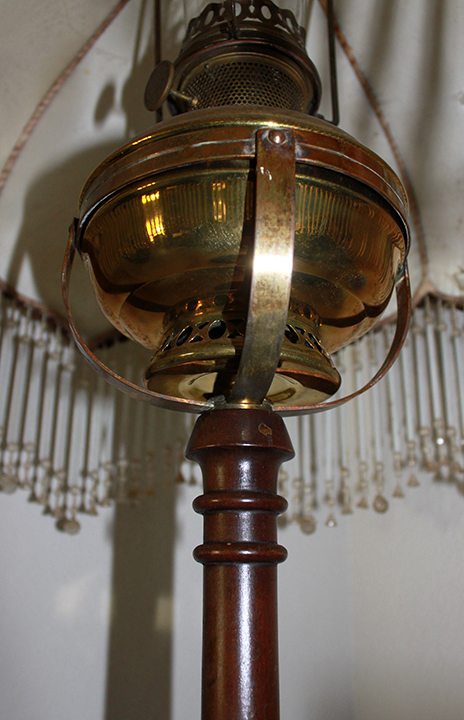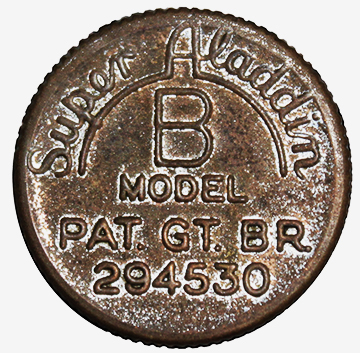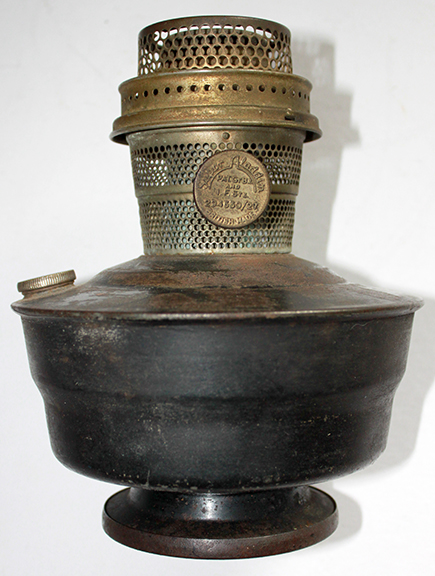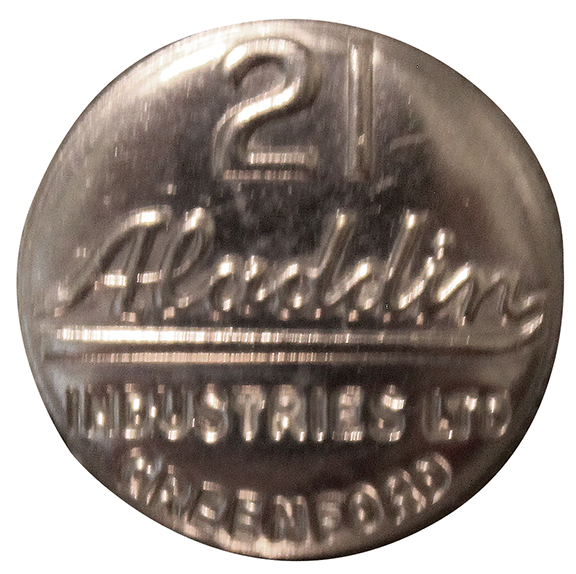| |

 |
|
|
An Introduction to Aladdin Industries Ltd. Also known as Aladdin England
In 1919 Aladdin England was created by Jack Imber, the British sales representative. The war had just ended and there was a strong market for Aladdin lamps. Aladdin USA built and shipped lamps to England that found markets throughout the British Empire. The lamps shipped to Aladdin England were standard production American lamps with a cover on the wick adjustment knob that read "Aladdin Industries Limited, or Ltd" and "LONDON". These were models 8, 9, 10, 11 and early 12. During this time Aladdin also provided American made wall mounts as well as ceiling hangers. Chance Brothers Glass in Staffordshire produced both glass shades and chimneys for these lamps. Aladdin England thought they could improve upon the flame spreader design and introduced their own flame spreader for the imported model 11 lamps. For marketing purposes Aladdin England referred to the table lamps as "Cottage Lamps" into the early 1930s then as table lamps. The taller basket lamps were marketed as basket lamps, and floor basket lamps as as "Standard lamps".
|
Models 8, 9, 10, 11, and early model 12
Basket Lamps
Early on Jack Imber decided that Aladdin England needed both a floor lamp and a taller table lamp that would not shine light directly into the eyes of people sitting across from one another at a table. It was too expensive to import large heavy American floor lamps and Aladdin Chicago did not offer a taller banquet style lamp. Aladdin England came up with the idea a metal basket to hold a font lamp on top of a pole which could be a floor lamp or tall "banquet" lamp. At this time the earliest mention of an Aladdin basket lamp I have found was in the "Ironmonger" issue November 25, 1922. This is the year the Aladdin model 11 was introduced. Two unique shade holders were offered with these basket lamps allowing large silk and art glass shades to be used on these lamps. Sadly few of these lamps seemed to have survived WWII and the succeeding years.
NOTE: Tilley basket lamps were made by the same company that made the Aladdin basket lamps
There are two different basket designs. One is deeper and rounded towards the base which fits the model 11 font lamps. The other is more square shaped to fit the model 12 font lamp. The basket banquet lamp I own has the early shaped basket with a US manufactured model 11 font lamp.

Aladdin model 11 basket and font lamp
|

Aladdin England model 11basket banquet lamp with silk shade
The stem and base are their standard mahogany stand.
|
Aladdin Industries Greenford
By 1930 the great depression was in full swing with millions of British workers out of work and had no real social safety net. A conference in Canada was called to protect and create jobs throughout the British empire by imposing massive tariffs on all imports. This was known as the Ottawa Conference. The goal was to make imported goods so expensive that local companies would increase production and hire more workers. These Tariffs would go into effect in 1933. In response Aladdin built a manufacturing plant in Greenford England which opened in 1931. Initially this new plant manufactured kerosene heaters. By the time the 1933 tariffs kicked in Aladdin Chicago had shipped a set of model A burner tooling to Aladdin England and by then the dies and presses were in place to stamp out the parts to create British designed lamp bodies. Aladdin Greenford made side draft model 14 burners based upon the model A tooling and all their own lamp fonts. Aladdin Chicago continued to ship model 12 burners, American swing arm wall mounts, tilt frame hangers, #3 ceiling mounting fixtures and bug screens to England after the tariffs went into effect. At the end of 1935 the model 12 was discontinued in both the USA and UK. Evidently the economics did not work out for Greenford to create the tooling for a burner that was to be a secondary product and would be discontinued in 3 years. Aladdin Greenford served as the Aladdin England home offices, sales offices and manufacturing facility. When the larger Pontardawe plant was opened in 1965 most manufacturing operations moved to Pontardawe. Wick weaving, mantle production and many assembly operations stayed in Greenford. Greenford remained open after the Pontardawe plant closed. Greenford closed in 1981 after mantle manufacturing had been moved to Brazil. When the Greenford plant closed the manufacture of Aladdin wicks went to Hattersley Ltd. a long established weaver of wicks. The Aladdin sales department moved to South Whales.
|
Side draft burners
Aladdin USA had purchased a glass company to make glass lamps and needed a side draft burner. Around 1930 they designed 2 side draft burners, model A and model B. The model A was intended for the American market and model B for the British market. Both were made in America and introduced in 1931. The model A was poorly accepted by the American customers largely due to the new method of rewickng the burner. So for 1932 the Model B was introduced in the American market and the Model A SuperAladdin was introduced in the British market.

1931 only, Aladdin England model B lamps made in the USA and shipped to England for sale. It is believed that these were only sold on table lamps.
|
 
|
The 1932 Super Aladdin model A burner was made in the USA and shipped to England. These are identified with "London" at the bottom of the wick adjustment knob. |
Once the model A tooling was in place and presses set up in Greenford to stamp both burners and lamp fonts the English made model 14 was introduced in 1933. The wick adjustment knobs were labeled "British Made". |
Bakelite
In the late 1930s as the UK was preparing for war, Aladdin England started experimenting with the new Bakelite plastic and designing future war products. As they perfected their molding techniques Aladdin introduced two Bakelite lamps, a table lamp and a shelf lamp. The shelf lamp looks like it could be used as a wall or hanging lamp but the diameter below the chime is too wide for the standard 6 inch Aladdin wall and ceiling hangers. The shelf lamps were cast from either black or brown bakelite. The table lamps were either left brown or painted. Production ended when the UK declared war on Germany in 1939.
|
 |
War years
During WWII brass became a restricted material so production of brass Aladdin lamps were stopped. Since kerosene lamps were still needed Aladdin produced a steel font lamp. Production focused on war related products ranging from special fuses for anti-aircraft shells to small kerosene heaters designed to be placed inside aircraft at night to keep condensation from depositing on aircraft interiors and creating rust. Aladdin escaped with little damage from bombing. |
 |
Model 21
At the end of WWII the country was nearly destitute with rationing continued into the 1950s. There was a very high demand for Aladdin products but the model 14 burner was becoming priced out of the reach for the people throughout the British empire who needed kerosene lighting the most. The countryside away from the cities were finally becoming wired for electricity and kerosene lighting was taking a secondary role inside the British isles. Work began on designing a cost reduced burner that improved upon weaknesses found in the model 14 burner. The new less expensive to make Aladdin 21 burner was introduced in 1953 and stayed in production into 1969. In 1965 the round wick model 21 adjustment knob was changed to a hexagonal shape. This was the first appearance of the Aladdin hexagonal shaped wick adjustment knob. This burner was successful and revived Aladdin Industries Ltd lamp decline.
SIDE NOTE AND QUESTION: During the winter of 1955-1956 a flood washed away the tooling and presses to manufacture the American model B burner. Aladdin Nashville spent the money to develop and tool up the inferior Model C burner. This money was spent while Aladdin England had a 3 or 4 year old successful cost reduced burner in production. Why didn't Aladdin Nashville just import burners from the UK or import a set of burner tooling? The Model C had hit and miss functionality. A further cost reduced model C burner was later designed in Brazil. This burner went into production as a steel burner and didn't burn as well as the Nashville model C burner. Finally in 1963 the model C Brazil was discontinued and Aladdin Nashville started importing the English made model 21 burner, adding a "C" to the 21. Aladdin Nashville could have saved the cost of designing and tooling up of 2 different inferior burners that costs customer acceptance if they had just adapted the superior model 21 burner right after the model B burner tooling was destroyed. Why did they ignore an already designed and customer tested design? Not invented here? Thinking they could design an even less expensive to manufacture burner?
|
 |
Aladdin Industries Pontardawe
After the war Aladdin civilian product demand grew at a rapid rate. In response to the need for expanded manufacturing space in 1954 Aladdin took over a failed factory in Pontardawe, Whales. This larger plant was more suited for manufacturing than the Greenford plant. By 1965 lamp & heater manufacturing was transfered from Greenford to Pontardawe. The Pontardawe plant closed in 1975 when model 23 lamp production ceased in the UK. Most of the model 21 lamps using the hex shaped burner and all the English made mode 23 lamps were made in the Pontardawe plant.
|
Post manufacturing
After the Greenford plant was closed down the Aladdin Industries Ltd sales department was all that remained to handle sales in Europe. They moved to South Whales where last I heard they still operate today.
|
|
| If you would like to discuss any of the contents
please feel free to
.
© 2002, 2015 by TeriAnn
Wakeman. All rights reserved.
This web site is not affiliated with Aladdin Mantle Lamp Company.
Aladdin, and Lox-on are registered trademarks of Aladdin Industries
LLC
|
|
|
![]()
![]() Contents An introduction to Aladdin
England
Contents An introduction to Aladdin
England










